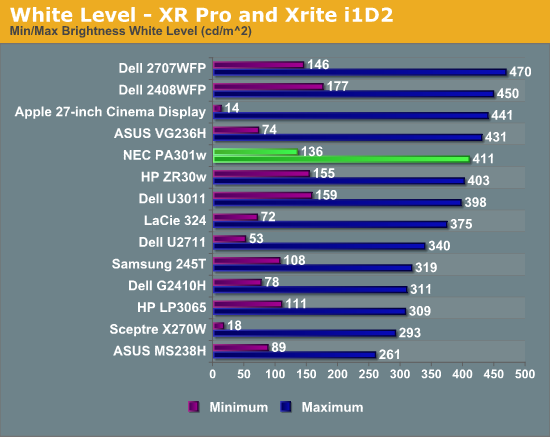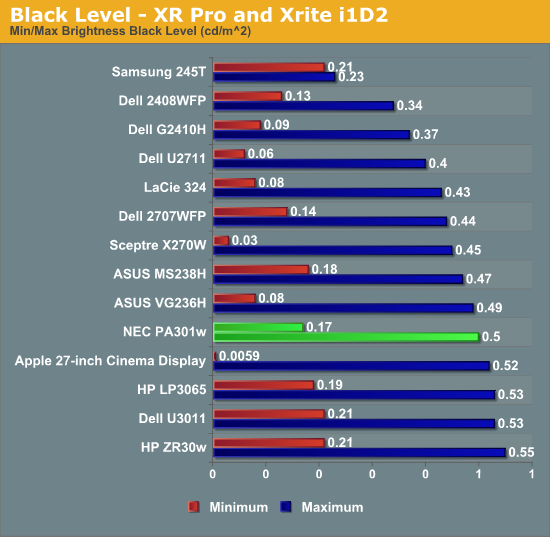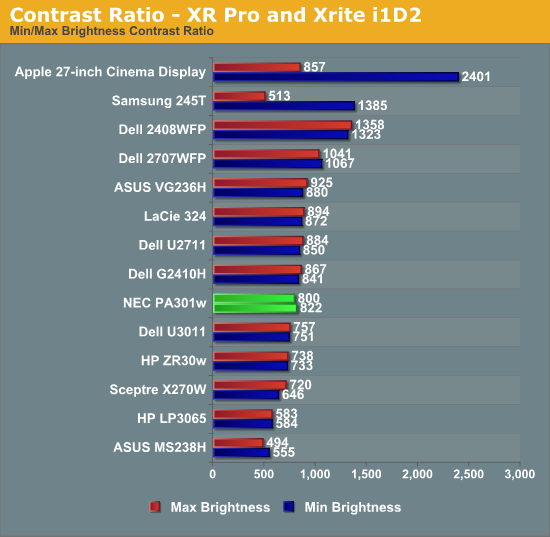NEC PA301w: The Baddest 30-inch Display Around
by Brian Klug on March 1, 2011 8:00 AM ESTBrightness and Contrast
For brightness, black level, and contrast points, we use the same colorimeter setup described earlier. Specifically, we use an Xrite i1D2 with ColorEyes Display Pro, and take measurements at maximum and minimum brightness of white and black targets. Dynamic contrast is turned off. We also let the panels settle in for a half hour at the respective settings before taking any measurements.
The PA301w uses a CCFL backlight, which makes that warm up time even more critical. The PA301w has an interesting quick warmup feature that reduces the visible brightness increase period dramatically. At power on, I measured brightness go from 160 nits (with the OSD showing 200 nits, blinking) to 210 nits in under one minute, then gradually settle to the desired 200 nits. There's a bit of overshoot, but the visual difference is hard if not impossible to actually pick out. For the sake of these tests, I waited for things to settle, but it's actually impressive how fast the PA301w can warm up to totally useable brightness levels.



Brightness settings in the OSD follow the same rules as color ones - if you select something impossible, the last changed value will show up pink, meaning it's outside of the monitor's capabilities. The same thing applies for brightness. I had no problem reaching 411 nits of brightness after getting that worked out - it's a similar thing I've seen on all other displays, sometimes you need to change contrast or color adjustment settings appropriately. Regardless, the PA301w went above the specified 350 nits of brightness, reaching 411. Contrast isn't quite the 1000:1 advertised typical, instead hovering around 800:1 pretty consistently.










92 Comments
View All Comments
7Enigma - Wednesday, March 2, 2011 - link
Are you seriously going to be frequently moving a 60+ pound display?erson - Tuesday, March 1, 2011 - link
Great review Brian. Regarding Eizo current FlexScan 30" is getting pretty "old". Their brand new 27" SX2762W with dual displayports (v1.1a) looks more interesting for the pro-consumer I imagine.Any word of monitors with displayport v1.2 support for daisy-chaining?
Conficio - Tuesday, March 1, 2011 - link
instead of "The baddest..."JarredWalton - Tuesday, March 1, 2011 - link
No. Bad, worse, worst is correct if you're talking about a negative connotation, but if you're using bad like in "oh, he's a total bad-ass!" you would never say, "Yeah, but I'm a worse-ass!" LOLLuay - Tuesday, March 1, 2011 - link
https://www.hazro.co.uk/shop.html#ecwid:category=4...They sell in the UK but do ship overseas and are priced cheaper than any 2560x1600 out there. You will find reviews for their models in TFT central.
DanNeely - Tuesday, March 1, 2011 - link
If you're asking about reviews; I believe that with rare exceptions review models are provided by the manufacturer not bought by the anandtech staff; so unless Hazro offers to send a review sample they won't be reviewed here.eaw999 - Wednesday, March 2, 2011 - link
warranty issues would be a pain for anyone overseas though.gammaray - Tuesday, March 1, 2011 - link
2200$+ ...is this a freaking joke?
DanNeely - Tuesday, March 1, 2011 - link
It's the same price as the outgoing 3090. Ezio sells high end displays for a similar price. These aren't intended as high end consumer displays like the Dell/HP models. They're aimed at professional customers; typically commercial photographers, and video producers.A big part of the price is probably panel binning, not all panels in a batch are equal and the manufactures charge a big premium for the best of the lot (less variation, fewer dead pixels, etc).
The image processor in the multisync 90 series added about $200 to the cost and was used to farther normalize variations across the panel so you didn't end up with things like a bright corner. I'd assume the current model's processor is less expensive, but probably not by a lot.
Finally the price premium from all the extra features that don't matter to consumers pushes the total cost up higher, since it cuts into the total customer base. $1300 vs $1800 is a big deal for a consumer on a budget, $1800 vs $2300 is much less for a (typically corporate) customer who has a need for the best on the market.
hp540 - Tuesday, March 1, 2011 - link
$2200 is not a joke. Actually, it's a drop in the bucket - depending on your perspective.I'm not a radiologist, but I read films as part of my work. Our radiology workstations use dual Eizo monitors. 2 x $2200 doesn't even come close to the full cost of these stations - it's not the workstations. It's not the computer. Most of the money the hospital pays is for the PAX software licensing fees.